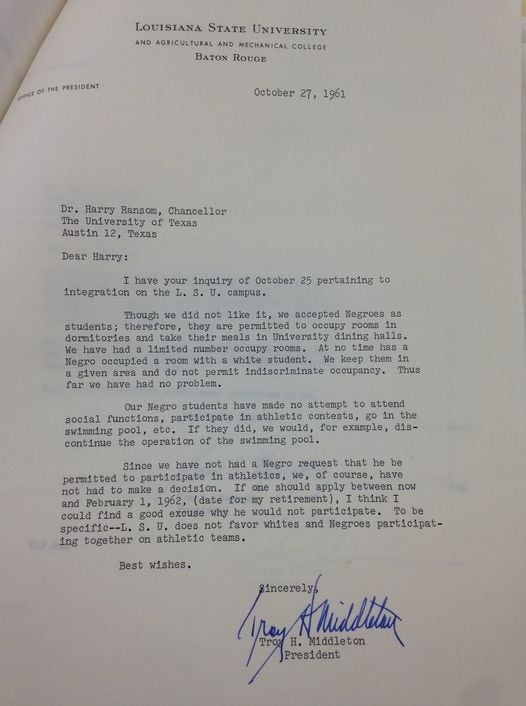The 1954 Brown v. Board of Education of Topeka decision by the U.S. Supreme Court was a landmark in civil rights history, as the court struck down the “separate but equal” doctrine that had enabled racial segregation in public facilities for decades. Most notably, the Brown ruling ended the practice of racial segregation in public schools — in law, at least, if not immediately in practice.
Some states followed the legal ruling and desegregated their public schools, but in others school administrators and government officials remained defiant. In one of the most renowned cases, James Meredith had to pursue a lawsuit against the state of Mississippi up to the Supreme Court in order to secure admission to the all-white University of Mississippi, while the state’s governor, Ross Barnett, refused to accept his enrollment. Likewise, in 1963 Georgia governor George Wallace famously blocked the doorway of the University of Alabama in a defiant attempt to prevent two Black students from enrolling.
In some states, previously all-white public universities reluctantly accepted the enrollment of Black students but nonetheless did their best to keep them apart from white students by maintaining non-integrated dormitories, extracurricular activities, and athletics programs. In 1954, for example, the University of Texas (UT) rescinded the admission of several Black students in order to preclude the possibility that they might try out for the school’s football team:
[L]ess than two weeks after Marion Ford had told the Houston Chronicle he wanted to try out for the football team, letters were sent to him and the other incoming African Americans, explaining that their admission had been rescinded. The university president, the regents, the university lawyers, and the state attorney general had huddled up and decided to bring down the full weight of the Texas government and its flagship university on this teenager and a half-dozen other African American admits for the crime of wanting to represent the school on the football field.
On September 3, Ford was refunded the $20 deposit for his room at a dormitory for Black students only, and he was informed by the university’s director for auxiliary and service activities that the rooming contract was “now voided.” “The Dean of Admissions at The University of Texas” — [H.Y.] McCown — “has notified this office that your application for admission to the University as a student has been canceled,” said the letter, a copy of which was sent to the university president, confirming again that the university’s highest ranks were involved.
Contrary to the law, into the 1960s the University of Texas continued to maintain dormitories for Black students that were not only separate, but decidedly unequal:
The segregated housing continued the tradition of treating African Americans as second-class citizens. The approved dormitories stood in terrible conditions. Historian Dwonna Goldstone describes them as “temporary ‘barrack-type residences’ across the street from the football stadium. None of the San Jacinto Dorms had air-conditioned rooms. Cliff Courts were privately owned group apartments in East Austin, a considerable distance from campus.” In 1958, the Daily Texan voiced its concerns about the inadequacy and segregated conditions of these dormitories, and advocated for full integration in the next years.
[P]rotests escalated in 1961 after a meeting held at Kinsolving Dormitory at the beginning of the school year aimed to establish the following rules: “(1) there were to be no black males in the lounges of white women’s dorms; (2) white women should not invite black women to their dorm; (3) if a white woman invited a black woman into the dorm, they were to go directly to the white woman’s room and shut the door; (4) a black man could enter the dorm only to deliver a message or food; and (5) black women could not use the drinking fountains or restrooms in white women’s dormitories.”
Amid those protests and lawsuits over the segregated dormitory facilities, according to Asher Price, UT’s chancellor, Dr. Harry Ransom, “wrote administrators at a number of other universities across the South to ask them how they had handled issues of desegregation.”
One of the other school administrators that Ransom wrote to was Troy H. Middleton, the president of Louisiana State University (LSU) from 1951 until 1962. Middleton’s response is the letter reproduced at the head of this article, in which he acknowledged that the school had begrudgingly accepted “Negro” students, but declared that they were not allowed to room with white students, that the school would “discontinue” (i.e., presumably drain) its swimming pool if Black students attempted to use it, and that he would fabricate an excuse to disqualify any “Negro” who sought to take part in a school athletic program:
Though we did not like it, we accepted Negroes as students; therefore, they are permitted to occupy rooms in dormitories and take their meals in University dining halls. We have had a limited number occupy rooms. At no time has a Negro occupied a room with a white student. We keep them in a given area and do not permit indiscriminate occupancy. Thus far we have had no problem.
Our Negro students have made no attempt to attend social functions, participate in athletic contests, go in the swimming pool, etc. If they did, we would, for example, discontinue the operation of the swimming pool.
Since we have not had a Negro request that he be permitted to participate in athletics, we of course, have not had to make a decision. If one should apply between now and February 1, 1962, (date for my retirement), I think I could find a good excuse why he would not participate. To be specific — L.S.U. does not favor whites and Negroes participating together on athletic teams.
In 2020, the LSU Board of Supervisors unanimously approved a motion to remove Middleton’s name from the university’s main library due to his segregationist policies while LSU president. That action was carried out within hours of its approval.
Is This 1961 Pro-Segregation Letter from LSU’s President Real?
Source: Kapit Pinas

0 Comments